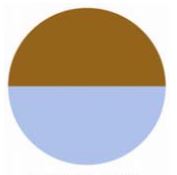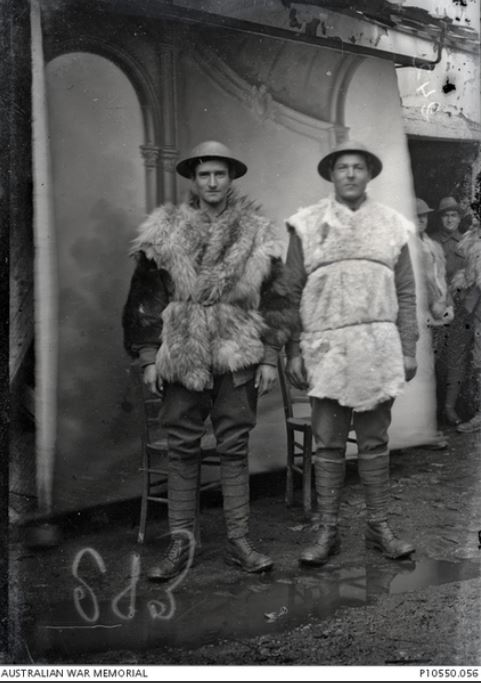Difference between revisions of "51st Battalion"
From Our Contribution
(→Battalion Personnel) |
|||
| Line 48: | Line 48: | ||
* [[Victor Emanuel Durling]] 1 Mar 1916 - 10 Jul 1916 (WIA Petillon Sector) | * [[Victor Emanuel Durling]] 1 Mar 1916 - 10 Jul 1916 (WIA Petillon Sector) | ||
* [[Albert John Egan MID]] 1 Mar 1916 - 27 Jan 1919 | * [[Albert John Egan MID]] 1 Mar 1916 - 27 Jan 1919 | ||
| − | * [[Richard Evans]] 1 - 16 Mar 1916 - to 4th Pioneer Battalion | + | * [[Richard Evans MM]] 1 - 16 Mar 1916 - to 4th Pioneer Battalion |
* [[Charles Fielder]] 14 Dec 1916 - 9 Jun 1917; 22 Oct - 24 Apr 1918; & 10 Oct - 1 Dec 1918 (WIA x 2) | * [[Charles Fielder]] 14 Dec 1916 - 9 Jun 1917; 22 Oct - 24 Apr 1918; & 10 Oct - 1 Dec 1918 (WIA x 2) | ||
* [[William Alfred Gallant MBE]] | * [[William Alfred Gallant MBE]] | ||
Revision as of 17:50, 28 February 2021
 Shoulder patch | |
 Sheepskin vests worn to ward off the cold of 1916/17 winter. AWM photo P10550.056 | |
Contents
Brief History
The 51st Battalion, Australian Imperial Force was raised at Tel-El-Kabir, Egypt, on 1 March 1916 from half of the 11th Battalion (veterans of the Gallipoli landing) and reinforcements of the 11th and 28th Battalions, all personnel being Western Australian volunteers. The Battalion was granted the colour patch chocolate brown over saxe blue.
The new Battalion was allotted to the 13th Infantry Brigade, 4th Australian Division with the 49th, 50th and 52nd Battalions, disembarked at Marseilles, France on 11 June 1916 and moved into the front line at Fleurbaix three days later.
The 51st Battalion's first major engagements with the enemy occurred at the ruins of Pozieres and Mouquet Farm during the period August - September 1916. During these engagements, the Battalion reached its objectives but was unable to hold the captured positions. In less than three weeks the Battalion had suffered in excess of 650 casualties. The Battalion then shifted to the quieter section of the battlefield in Belgium. There its major battle was with the rain and the mud and at one stage the Battalion was down to approximately 300 men due to the shocking conditions they fought in.
On the morning of 2nd April,1917, the Battalion along with the 50th Battalion attacked Noreuil, an outpost village near the Hindenberg Line. The attack was a success, but the Battalion suffered 239 casualties during the assault and subsequent defence of the village. The next major engagement of the 51st Battalion was the counter-attack at Villers Bretonneux on 24/25 April 1918, during which action the Battalion lost 389 men in just two days. Lieutenant C.W.K. Sadlier won the Victoria Cross for his valour during the engagement. For the action, the Battalion was awarded a total of 4l decorations. The depleted 52nd Battalion was incorporated into the 51st Battalion to make up the numbers for the rest of the war.
Battalion Personnel
- Hubert Maitland Armstrong MM 15 Apr 1917 - 15 Oct 1918
- Edward Patrick Barker 3 Mar 1916 - 9 Feb 1919
- Joseph George Benton Jnr 6 Apr - 25 Apr 1918 WIA
- † Albert Victor Berry 23 Dec 1916 - 25 Apr 1918 (KIA Villers-Bretonneux)
- George Edward Binns 3 Mar 1916 - 18 Apr 1918
- Clyde Bird 2 Apr 1916 - 15 Sep 1918 (WIA x 4)
- Thomas Bird 30 Apr 1916 - 15 Aug 1916
- Charles Blunt 15 Jul 1917 - 13 Mar 1918
- † John McLeod Brown 2 Apr 1916 - 27 Jun 1916 (Accidental death)
- Henry (Harry) Butcher 24 Sep 1917 - 19 May 1919
- William Edward Butcher MM RMG MID 29 Feb 1916 - 12 Mar 1919
- Ernest Camp 6 - 30 Apr 1918
- Victor Norman Chandler MM 3 Mar 1916 - 1 Sep 1917 & 10 Feb 1918 - ?? Jan 1919
- † Bernard William Chatfield 29 Feb - 3 Sep 1916 (KIA Mouquet Farm)
- Henry Thomas Cockram 1 Mar - 16 Aug 1916 (WIA Mouquet Farm)
- William Francis Combs 13 May 1917 - 24 Mar 1918 (WIA x 2)
- George Sidney Cook 29 Feb 1916 - 30 Oct 1918
- Francis Crowe 3 Mar - 9 Aug 1916 (WIA Mouquet Farm)
- † Walter Edward Dalziell 29 Feb 1916 - 14/16 Aug 1916 (KIA Mouquet Farm)
- Charles Henry Davis 1 Mar 1916 - 9 Jan 1919 (WIA Mouquet Farm)
- Gordon Devereux MM 29 Feb - 27 Aug 1916 & 2 May - 18 Aug 1918
- Alexander Donald 2 Apr 1916 - 9 Jun 1917 (WIA Messines Ridge)
- † Thomas William Dowell 21 Aug - 5 Sep 1916 (KIA Mouquet Farm)
- Victor Emanuel Durling 1 Mar 1916 - 10 Jul 1916 (WIA Petillon Sector)
- Albert John Egan MID 1 Mar 1916 - 27 Jan 1919
- Richard Evans MM 1 - 16 Mar 1916 - to 4th Pioneer Battalion
- Charles Fielder 14 Dec 1916 - 9 Jun 1917; 22 Oct - 24 Apr 1918; & 10 Oct - 1 Dec 1918 (WIA x 2)
- William Alfred Gallant MBE
- † Charles Maul Glover 1 Mar - 3 Sep 1916 (KIA Mouquet Farm)
- † John Francis Grabham MM 19 Apr 1916 - 15 Nov 1918 (Died of illness)
- † William Harwood 20 May 1916 - 14 Oct 1917 (KIA Passchendaele)
- Leslie Hetherington 25 Apr - 26 Sep 1917 (WIA Polygon Wood)
- Ellis Henry Hill 10 Feb 1917 - 5 Nov 1918
- John Henry Holroyd 20 May 1916 - Jun 1919
- † John Huntley 2 Apr - 18 Aug 1916 (KIA Poziéres)
- † Fritz Robert Jaentsch 29 Jan 1916 - 12 Oct 1917 (KIA Passchendaele Ridge)
- † Thomas William Kerry 3 Mar 1916 - 2 Apr 1917 (KIA Noreuil)
- James Kershaw 1 -14 Mar 1916 - to 4th Pioneer Battalion
- Edward Joseph King 23 Dec 1916 - 12 oct 1917 (WIA)
- † George Andrew King 14 Dec 1916 - 28 Nov 1917 (DOW Passchendaele)
- Roy Walden King 19 Dec 1916 - 9 Jun 1917 (WIA Messines Ridge)
- Daniel Adkins Lewis 22 Jan 1917 - 11 Aug 1918
- Herbert George Lewis 3 - 23 Apr 1916 & 23 Jul - 26 Aug 1916 (POW Mouquet Farm & DOW)
- † Charles Leonard Lockhart 13 May - 12 Oct 1917 (DOW Westhoek Ridge)
- Stanley Thomas Marsh 15 Jul 1917 - 25 Apr 1918 (WIA Villers-Bretonneux)
- † Leonard Roy Matthews 3 Mar 1916 - 3 Sep 1916 (KIA Mouquet Farm)
- Charles Frederick McKay 2 Apr 1916 - 8 Jan 1917
- † Ernest James Mead 1 Jan 1917 - 24 Apr 1918 (KIA Villers-Bretonneux)
- Henry Joseph Milne ?? Apr - 29 Sep 1916
- Leonard George Morgan 28 Jan 1917 - 11 Mar 1918
- William Bertie Claude Moulden 22 Jan - 4 Apr 1917
- James Richard Parry (Dick) Murray 2 Feb - 20 May 1919
- William Richard (Billy) Orr 25 Feb - 25 Apr 1918 (WIA Villers-Bretonneux)
- Henry Ivor Passmore DCM 13 Mar 1918 - 10 Jun 1919
- Keith George Harman Podger 19 Apr - 16 Aug 1916 (KIA Mouquet Farm)
- William Rawlinson 3 Mar - 20 Oct 1916
- John George (Jack) Ray 20 Aug 1918 - 10 May 1919
- † Charles Joseph Gerald Raynor 3 Mar - 3 Sep 1916 (KIA Mouquet Farm)
- Francis Henry Ryniker 3 Mar - 3 Sep 1916 (POW)
- † Felix Edmund John Sainsbury 10 Feb - 9 Jun 1917 (KIA Messines)
- George Sanderson 19 Jan - 6 Apr 1917
- † William Savage 13 May - 26 Sep 1917 (KIA Polygon Wood)
- Henry Giles Schmidt 1 Mar 1916 - 10 Feb 1917
- † Ernest Selkirk MID 3 Mar 1916 - 9 Jun 1917 (KIA Messines)
- Frederick Selkirk 16 May 1918 from the 52nd Battalion
- † Frank Leslie Sexton 2 Apr 1916 - 2 Apr 1917 (KIA Noreuil)
- John (Junior) Shepherd 13 Mar 1918 - 31 Jan 1919
- William Simpson 23 Dec 1916 - 11 Apr 1917 (WIA Bullecourt)
- Ernest (Roy) William Sladden 15 Feb - 7 Sep 1917
- † Herbert Charles Smith 19 Feb - 2 Apr 1917 (KIA Noreuil)
- Harold Hopgood Surman 15 Jul - 26 Sep 1916 (WIA Polygon Wood)
- James Thomson MM 7 Oct 1916 - 13 Mar 1919
- † Samuel James Verrier 7 Feb - 1 Apr 1917 (KIA Noreuil)
- Samuel Arthur Vincent 16 Aug - 15 Sep 1918 (WIA near Péronne)
- † William Paul (Layton) Walton 14 Dec 1916 - 2 Apr 1917 (KIA Noreuil)
- Clarence Victor Watson 20 Oct 1916 - 22 Apr 1918 (WIA 2 Apr 1917 Noreuil)
- John Whittaker ?? Jun 1916 - 10 Jun 1917 (KIA Messines)
- John Henry Wilkinson 17 Nov 1916 - 10 Apr 1919
- Vernon Claude Witney
- William Charles Woodland 2 Mar - 3 Sep 1916 (POW & WIA Pozieres)
- Vernon C Witney
Battle Honours
- Egypt 1915-1916
- Somme 1916
- Somme 1918
- Pozieres
- Bullecourt
- Messines 1917
- Ypres 1917
- Menin Road
- Polygon Wood
- Passchendaele
- Ancre 1918
- Villers-Bretonneux
- Hamel
- Amiens
- Albert 1918
- Hindenburg Line 1
- Hindenburg Line 2
- Epehy
- France and Flanders 1916-1918
Individual Honours
- 1 Victoria Cross (Lt Clifford Sadlier)
- 2 Distinguished Service Orders, and one bar
- 1 Officer of the Order of the British Empire
- 15 Military Crosses and two bars
- 14 Distinguished Conduct Medals
- 110 Military Medals and three bars - (Hubert Maitland Armstrong MM);(William Edward Butcher MM RMG MID);(Victor Norman Chandler MM);(Gordon Devereux MM);(John Francis Grabham MM)
- 9 Meritorious Service Medals
- 30 Mentioned in Despatches, and - (William Edward Butcher MM RMG MID);(Albert John Egan MID);(Ernest Selkirk MID)
- 7 foreign awards - (William Edward Butcher MM RMG MID)
Notes
Information obtained from 51st Battalion Association[1]
- ↑ http://51fnqra.businesscatalyst.com/worldwar1.html accessed 3 jan 2018